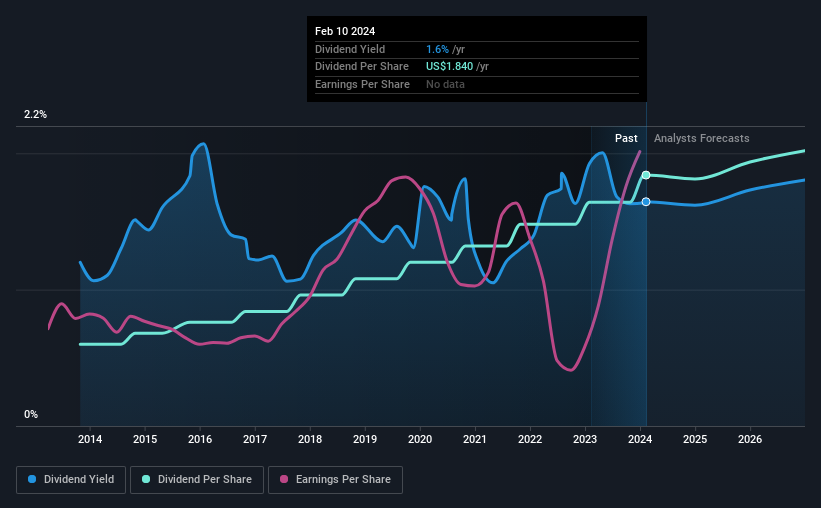There's A Lot To Like About Oshkosh's (NYSE:OSK) Upcoming US$0.46 Dividend
It looks like Oshkosh Corporation (NYSE:OSK) is about to go ex-dividend in the next 3 days. The ex-dividend date is one business day before a company's record date, which is the date on which the company determines which shareholders are entitled to receive a dividend. The ex-dividend date is important because any transaction on a stock needs to have been settled before the record date in order to be eligible for a dividend. This means that investors who purchase Oshkosh's shares on or after the 14th of February will not receive the dividend, which will be paid on the 29th of February.
The company's next dividend payment will be US$0.46 per share, on the back of last year when the company paid a total of US$1.84 to shareholders. Looking at the last 12 months of distributions, Oshkosh has a trailing yield of approximately 1.6% on its current stock price of US$111.89. Dividends are a major contributor to investment returns for long term holders, but only if the dividend continues to be paid. We need to see whether the dividend is covered by earnings and if it's growing.
Check out our latest analysis for Oshkosh
If a company pays out more in dividends than it earned, then the dividend might become unsustainable - hardly an ideal situation. Oshkosh is paying out just 18% of its profit after tax, which is comfortably low and leaves plenty of breathing room in the case of adverse events. Yet cash flow is typically more important than profit for assessing dividend sustainability, so we should always check if the company generated enough cash to afford its dividend. It distributed 39% of its free cash flow as dividends, a comfortable payout level for most companies.
It's positive to see that Oshkosh's dividend is covered by both profits and cash flow, since this is generally a sign that the dividend is sustainable, and a lower payout ratio usually suggests a greater margin of safety before the dividend gets cut.
Click here to see the company's payout ratio, plus analyst estimates of its future dividends.
Have Earnings And Dividends Been Growing?
Stocks in companies that generate sustainable earnings growth often make the best dividend prospects, as it is easier to lift the dividend when earnings are rising. Investors love dividends, so if earnings fall and the dividend is reduced, expect a stock to be sold off heavily at the same time. This is why it's a relief to see Oshkosh earnings per share are up 5.0% per annum over the last five years. Recent earnings growth has been limited. However, companies that see their growth slow can often choose to pay out a greater percentage of earnings to shareholders, which could see the dividend continue to rise.
Many investors will assess a company's dividend performance by evaluating how much the dividend payments have changed over time. In the past 10 years, Oshkosh has increased its dividend at approximately 12% a year on average. It's encouraging to see the company lifting dividends while earnings are growing, suggesting at least some corporate interest in rewarding shareholders.
Final Takeaway
Is Oshkosh worth buying for its dividend? Earnings per share have been growing moderately, and Oshkosh is paying out less than half its earnings and cash flow as dividends, which is an attractive combination as it suggests the company is investing in growth. It might be nice to see earnings growing faster, but Oshkosh is being conservative with its dividend payouts and could still perform reasonably over the long run. Oshkosh looks solid on this analysis overall, and we'd definitely consider investigating it more closely.
Ever wonder what the future holds for Oshkosh? See what the 16 analysts we track are forecasting, with this visualisation of its historical and future estimated earnings and cash flow
If you're in the market for strong dividend payers, we recommend checking our selection of top dividend stocks.
Have feedback on this article? Concerned about the content? Get in touch with us directly. Alternatively, email editorial-team (at) simplywallst.com.
This article by Simply Wall St is general in nature. We provide commentary based on historical data and analyst forecasts only using an unbiased methodology and our articles are not intended to be financial advice. It does not constitute a recommendation to buy or sell any stock, and does not take account of your objectives, or your financial situation. We aim to bring you long-term focused analysis driven by fundamental data. Note that our analysis may not factor in the latest price-sensitive company announcements or qualitative material. Simply Wall St has no position in any stocks mentioned.

